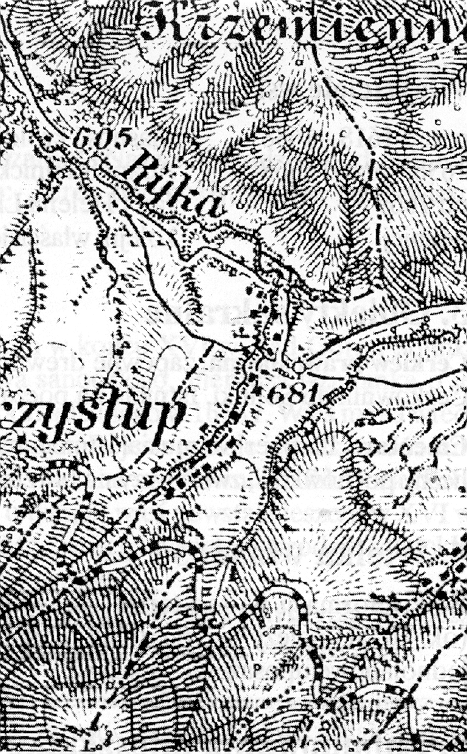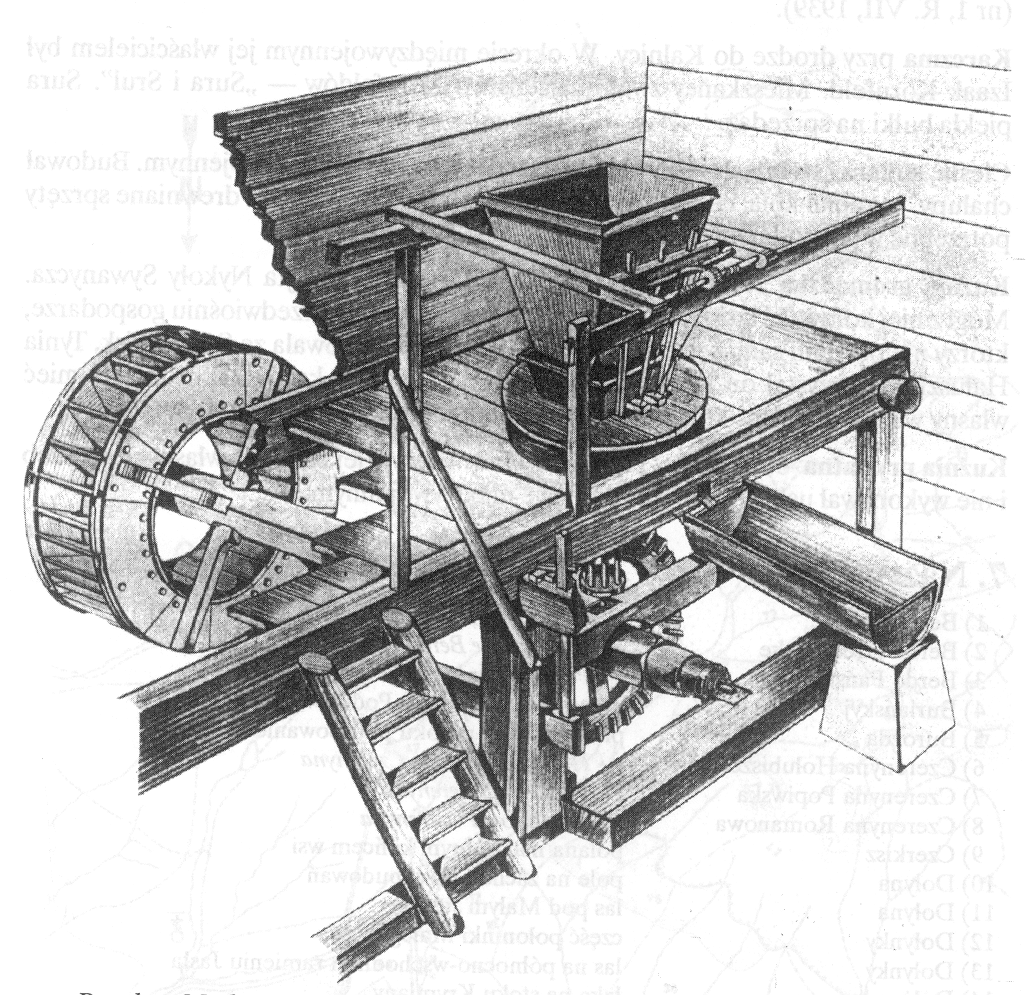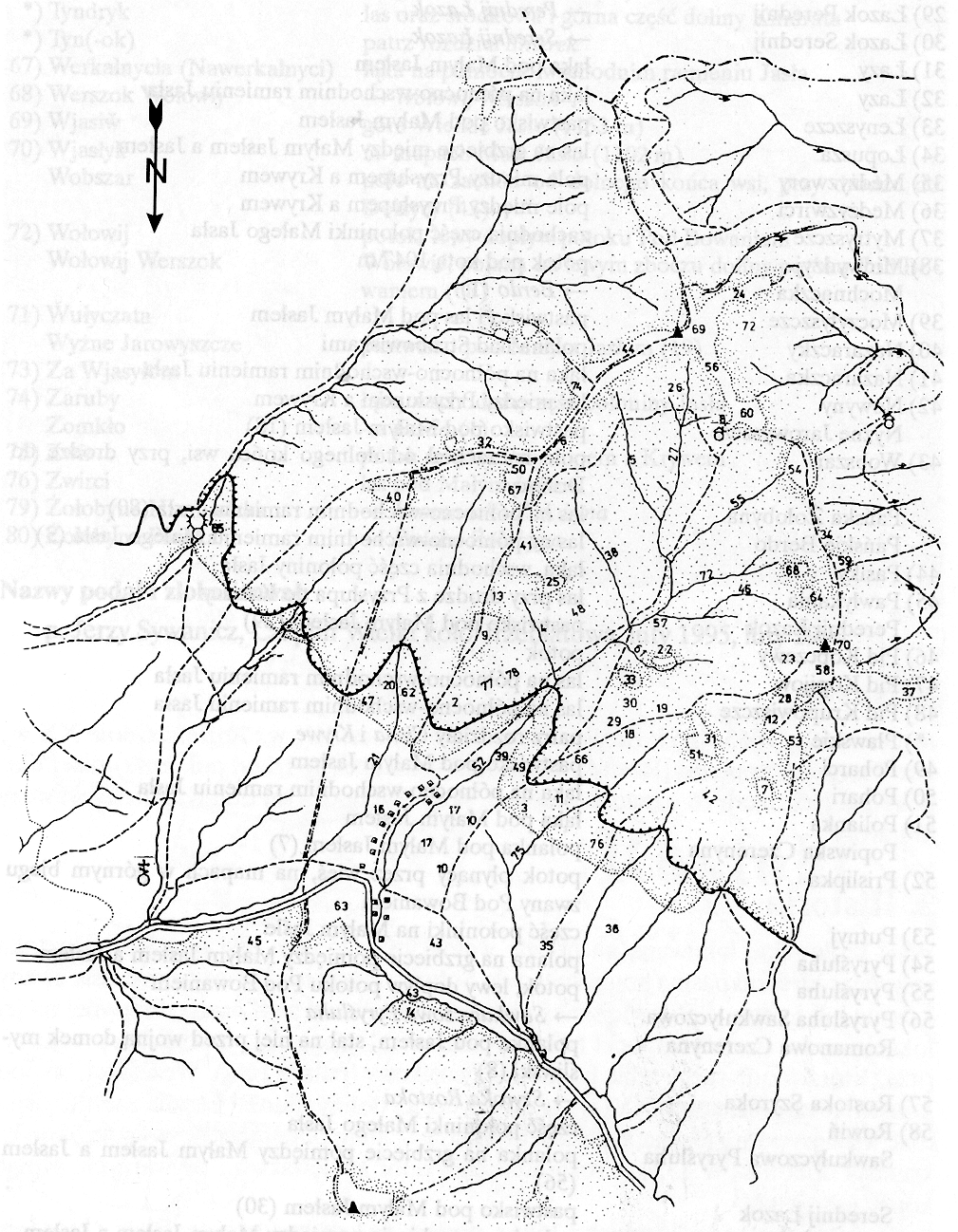






 |
 |
 |
 |
 |
 |
 |
Przyslop 1552; Przislop 1567; Przeslup 1589; Przyslup 1608, 19th and 20th centuries; in Ukrainian Pryslip. The name comes from the Romanian word prislop, which means the valley that joins two parallel mountain peaks.
 |
Przyslup on the Austrian topographical map 1:75 000 from 1914. Double zoom. /enlarged to twice the size/. |
The village is located almost [woloskim] head of the stream Dolzyca in the properties of the Bal family of Hoczew. Its name comes from local flows between massive Jasla and Falowej. Przyslup existed since 1567 and had been until then under wolnisne law. It began therefore after 1543. Here the local count had one lan of land. According to local tradition, the first settlers were three shepherds.
Przyslup can thank Matiasza Bal III for settlement. From the beginning of its existence up to 1939 it remained part of the Cisna key and together same owner. In the early 17th century it was the Bal key - Matiasz IV, Samuel and Mikolaj. In the first half of 18th century the Cisna key became the property of the Jew Michal Urbanski. Around 1740, through marriage with Teresa Urbanski, her possessions went to Josef Benedykt Fredo. He, his son Jacek as well as nephews Julian and Henryk were landlords of these possessions until 1867.
In 1868, the acreage of the village amounted to 1440 morg (828.7 ha), of this forests 1067 morg (614.1 ha). Cultivated land of the peasants included arable fields of 90.9 ha; meadows and gardens 75.4 ha; pasture 28.2 ha. All of the forests belonged to the great estate.
In 1872 Michal Gondor died in Przyslup (l. 27), who returned from service in Austria with the 45th Archduke Zygmunt Infantry Regiment.
The second half of the 19th century this place brought new wealth to the proprietors. These were the barons Flemming de Arnim. In the later years of this century, the properties of Cisna and Przyslup were purchased by Herman Czecz de Lindenwald. Through his initiative in the years 1900-1904 the narrow gauge railroad from Majdan to Kalnica was constructed. Financial investment for the railroad was provided by the owners of the forest estates in Cisna and Kalnica. This is also why the railroad borders the forest, in order to avoid the costly purchase of the peasants' land for construction of the railroad.
From 1904 -1939 the Cisna key belonged to a Jewish family named Baeckenrothow.
In 1910, at the age of 80 years, a local beggar Andrzej Drozdowski died in Przyslup. It is interesting that in spite of his noted profession, he was known by his name and age. Certainly he was greeted in the village with much respect. His surname is recognized as coming from a Polish landowning family.
During World War I the village did not suffer any destruction except for the burden of the armies marching across the land.
The main food in the village between the two wars was sauerkraut, potatoes, oat pancakes, white and red borsht, kiselycia (made from oat flour), pierogi, bread made from oats or rye, milk, cheese, beans, peas, cucumbers, pumpkins, garlic, carrots, onions and chives. In the summer they frequently consumed varieties of mushrooms and berries: black berries, blueberries, raspberries. In the fall they collected mushrooms called h»ywy, which grow in old dry beech forests. They planted potatoes, oats, rye, and barley. Wheat was not planted because in never ripened. They planted flax, hemp (later very little of this) to obtain fibers.
They raised horned cattle, horses, pigs, chickens, but sheep only rarely. There was always a lack of daily meat or fat. Nobody owned large orchards. Only by the houses they would grow a few fruit trees, mostly pears and apples. They also had a lot of cherries and plums, only one farmer had gooseberries.
*** By GRW to next ***
cows dairy forests and forest fields hayfields, also peasant meadows which picked mushrooms Wielkiego and Malego Jasla. Cows were daily turned out to pasture and in the evening were herded and returned to the cattle barns. After such roaming, (sometimes up to 10 kilometers) cows gave little milk (2.5 liters and less). However, heifers and bulls were not brought to the village for the night. [Pasiono] them the fields of Wielkiego and Malego Jasla. They built there huts through which spend the night fire [watry]. The cattle gathered around the fire, near which the shepherds slept.
The women spent the winter season making linen needed for the home. First, yarn thread from flax and hemp were made on spinning wheels (earlier on spindles). Yarn making usually began at the beginning of February. To fabric used looms and very modern workshops. About two months were devoted to making fabric. Until the beginning of the 20th century they also made cloth. There was fabric from clean combed wool [powierzchni spilsnionej] effort [folowania] . The nearest fulling mills (known as stupami) were found at Wolkowyi and Zawoju.
During the interwar period residents of the village went for indulgence to Lopienka (for druhu Matkobisku, also known as Holy Mother's Birthday - September 19) and Mchawa ( for Spasa, also known as Holy Lord's Transformation -August 19). For these indulgences, very many people came from the surrounding villages.
To the village arrived wandering merchants with pots as well as [maziarze] from Nowy Sacz with tar and grease carried in wagons. It is possible to suppose that they were the famous Lemko maziarze from Losia near Gorlic. For their merchandise they demanded grain or money.
In the years 1920-1936 the mayor of Przyslup was Nykola Sywanycz. At least he was illiterate, three times he went to America to earn money, the first time in 1904. When he returned after two years, he completed at the beginning of construction house that was started earlier. He returned a second time in 1907. He returned this time after four years, in order to help his wife who was independently managing the farm household and raising three small children. After the third time he emigrated in 1914 and returned after six years. Not surprisingly, that such a celebrated man became instantly elected mayor.
***
In the 1930's in the village lived 35 families with the names: Bihun (1), Frycz (1), Gondir (1), Hutnyk (1), Hyszta (3), Kalynycz (1), Kolesar (2), Lachawczak (2), Lawriwskyj (1), Markanycz (1), Michawczak (1), Mynta (2), Nykolyszak (1), Pliszka (5), Pszyk (1), Sawkalycz (1), Slywkanycz (2), Strungowski (2), Sywanycz (2), Wasylkiw (3), Zubal (1). The Kalynycz family was a Gypsy family.
Frequently there were nicknames, which were used in every day conversation and were substituted for the surnames. Here are some of the nicknames: Brandziar, Bzdonia, Cupryk, Holobiszczak, Hyrmot, Koczerawczyk, Masniak, Paranycz, Pelypania, Sywackyj, Triszczocha, and Wajdycha.
There was also one Jewish family in the village Izaak and Sura Kornfeldowie. They arrived in the late 1880's from Carynski. They were very poor. As described by one of the inhabitants of the village, they came with only a single egg for Passover. He was running a pub and by the early 1920's they made enough money to buy a house that was covered with shingles. The local peasants drank to such a degree at the pub that they became indebted and they lost their land. Finally the peasants became aware of what was happening and they bought less and less from the Kornfelds, which caused them to become very upset and they were finally starving. They were killed by the Germans in the early 1940's.
In the mid-1930's a man named Michalski arrived in Przyslup from Poznan who lived with the Kornfelds and began constructing his own house. After it was finished he leased it as an outpost to the border guards, of which he became the commander. In 1939 the commandant Michalski, along with his family, ran away from the Germans to the East. When the occupation, they returned. Because his house and the guard post connected with it were occupied by the Grenzschutz, he started living in the house left by the Kornfelds. He spoke good German, signed the Volksliste, and started working for the Germans. Having a team of horses he would travel over the neighboring villages collecting taxes (in the form of cattle and pigs). Everybody was afraid of him because he was a very bad man and could hurt anybody. In 1944, along with his son Bogdan, he was executed by some underground unit. The execution was carried out not far from the village near the forest. Shortly thereafter the rest of his family left Przyslup. Shortly thereafter, the outpost and the Jewish house were burned down by partisans of the UPA.
The only fatality of the crossing of the front lines, in the summer of 1944, was a farmer Hryc Mynta on whose front yard a mortar shell exploded. During the fighting over Przyslup a German fighter aircraft was shot down and fell in the part of the village called Dudniaczka.
*** By GRW to next ***
On March 16, 1945 partisans of the UPA detained in the village two gmina messengers, dispatched with instructions forbiding a carter to transport wood for PUBP in Lesko. The partisans ordered them to tell in the gmina, that the carter didn't give.
On March 21, 1945 the UPA sotnia "Weselej" fought heavy, many hours battle with repeatedly stronger division of NKWD. The partisans were quartered on the ridge distributed between Przyslup and Strubowiska. The attack of the NKWD army came from the side of Przyslup.
In 1944 the new administration selected 215 people to be expelled to Ukraine, but by the end of May 1945 none of the notified left voluntarily. In connection of this spring of 1946 expelled obligatory 28 families. The remaining inhabitants (6 families) were expelled during the Akcji Wisla between April 28 and May 10, 1947. Subsequently before polish army arrested four inhabitants ages 16 - 17 years. These were Hryc and Seman Pliszka as well as Mychajlo and Nykola Wasylkiw. All were sent to the concentration camp at Jaworznie. They stayed there until released in 1948. After expulsion from the village nobody remained.
In the 1960's about a dozen new homes were built in Przyslup, while in the 1970's several additional. Currently the village has 20 homes and is the site of the soltys, which also includes Krywe.
Owners of the Village
| 1567-1585 | Mateusz Bal III (son of Miko»aja) |
| 1589-before 1648 | Mateusz Bal IV (son of Mateusz) |
| before 1648-1651 | Samuel Bal (brother of son of Matuesz IV) |
| 1633 | Mikolaja Bal III (son of Samuel) |
| about 1720-about 1740 | Michal Urbanzki (died 1748) |
| about 1740-about 1790 | Jozef Benedykt Fredo |
| before 1790-about 1820 | Jacek hr. Fredo son of Jozefa (1760-1828) |
| about 1820-1829 | Julian hr. Fredo, son of Jacka (1797-1829, died without children) |
| 1829-1867 | Henryk hr. Fredo, son of Jacka(1799-1867) |
| 1867-1868 | Henryk baron Flemming de Arnim |
| 1873-about 1888 | Fryderyk baron Flemming de Arnim |
| about 1888-before 1893 | Maria hr. Weissenfeld and Joanna Karlowitz (bought estate from F. Flemming) |
| before 1893-1904 | Herman Czecz de Lindenwald (1854-1904) |
| 1904 | Jozef Fenerstein and two partners (one certainly was Eisig Baeckenroth) |
| after 1904-before 1914 | Jozef Fenerstein and Eisig Baeckenroth |
| before 1914-1939 |
Baeckenroth |
Wojt (Mayor):
1920-1936 Nykola Sywanycz
Soltys: (village head, below Wojt)
1936 - about 1940 Petro Wasylkiw
about 1940-about 1944 Mychalo Gondir
about 1944-1947 Pawlo Mynta
Border Outpost. Existed during the interwar period. In the late 1930s outpost commander was Michalski, who built it as his home and leased it to the Border Guard. The guard post had about ten soldiers. Among them were Jankowski, Nocon and Majewski from Limanow. Part of the garrison outpost lived in Strubowiska with the Jew Herszko.
Grenzschutzu Watchtower. In the years 1939-1944 there existed in the village a watchtower Grenzschutzu., it was located at the site of the older Polish sentrypost Border Outpost. In 1944 at once after the passing of the front the outpost was burned by UPA partisans. The Germans built a new outpost at the upper end of the village. The second rose above Wielkim Jasle, near the same border.
Number of People by Faith
Year |
Number of Houses |
Number of Residents |
Greek Catholic |
Roman Catholic |
Jewish |
Other |
| 1785 | 62 |
62 |
0 |
0 |
0 |
|
| 1831 | 102 |
|||||
| 1847 | 139 |
|||||
| 1849 | 122 |
|||||
| 1857 | 118 |
|||||
| 1867 | 109 |
|||||
| 1869 | 24 |
132 |
||||
| 1873 | 114 |
|||||
| 1879 | 112 |
|||||
| 1880 | 22 |
137 |
133 |
0 |
4 |
0 |
| 1884 | 160 |
|||||
| 1890 | 170 |
|||||
| 1895 | 139 |
133 |
0 |
6 |
0 |
|
| 1904 | 166 (?) |
|||||
| 1910 | 178 |
172 |
0 |
6 |
0 |
|
| 1914 | 207 |
|||||
| 1918 | 182 |
|||||
| 1921 | 30 |
159 |
153 |
|||
| 1921 | ||||||
| 1930 | 180 |
173 |
1 |
6 |
0 |
|
| 1936 | 198 |
|||||
| 1938 | 38 |
218 |
||||
| 1939 | 36 |
264 |
||||
| 1943 | 241 |
|||||
| 1945 | 215* |
|||||
| 1947 | 70/0** |
|||||
| 1995 | 20 |
73 |
* Only the persons designated for resettlement.
** Before and after Akcji Wisla.
Education and Culture
Cantor
Church organizations
Cemetery
The largest property here was undoubtedly consisted of forests. They did not have any estates. In 1868 and 1890 the large ownership consisted of 634.1 ha, of this meadows 1.16 ha, orchards .09 ha, pasture 18.9 ha, forests 614.1 ha, and inhabited area 5.25 a.
During the interwar period the village only had homes built of lumber. All were covered with straw except two were covered with shingles and one was covered with sheet metal.
Narrow gauge railroad from Majdan to hamlet of Beskid in Smerek. In the years 1900 - 1904 the segment from Majdan to Kalnica was constructed and in the years 1908 - 1909
Grease house
 |
Przyslup. Water Mill Mechanism |
Water mill was under the stream called Pod Boweniem, in a place which intersected the old road from Krwy to Strubowisk. It was probably founded in the middle of the 19th century. In 1865 died millman Bazyli Holik (age 44). During the interwar period the mill belonged to the gmina of Przyslup. In the 1920's-1930's the miller was Seman Pliszka. He himself made the water wheel and sharpen the grinding stones. After him and until the deportations the miller was Petro Wasylkiw. The wooden building of this mill which was covered with straw laid on the left side of the stream. The water was lead dirctly to the water wheel from a main run with the assistance of a wooden trough. In the 30's the mill rarely functiond due to lack of water. When it worked mainly oats were ground, rarely barley or rye. The productivity of the mill was in the neighborhood of 100 -200 kg of grain per day.
This mill was rebuilt in the late 1930's by W. Korzeniewicz and W. Swiatecki during what was known as the Section of Reconstruction and Peoples Art Architecture of the Polish Polytechnic in Warsaw. The drawing displaying the mechanism of the mill was published in the Bulletin of History of Art and Culture Number 1, in 1939).
Karczma along the road to Kalnica. Its owner during the interwar period was Izaak Kornfeld. The inhabitants called this Kornfeld couple "Sura" and "Srul" . Sura would bake rolls to sell.
Carpenter, cabinet maker, and cartwright -Sywanycz. Had this job during the interwar period. He would build houses, made wheels, complete carriages, sleds, tables, windows and all kinds of wooden items needed in the households.
The community forge was built around 1930 under the initiative of village mayor Nyko»y Sywanycza. Anybody could take advantage of it being there if you knew the art of smithing. In the spring the farmers who couldn't handle certain jobs themselves would hire the smith from Strubowiska, Tynia Ha»uszko. To take advantage of this community forge, each person had to bring his own charcoal burned from the knots of spruce trees or fir trees.
Private forge - owned by Petro Wasylkiw. Used only for his personal needs, he did not provide any commercial services. It functioned during the interewar period.
Nicknames of local areas
(1) Berdo-Precipice and mountain shown on the map as deer's jump (elevation 777m)
(2) Berdo Hromadzke-
(3) Berdo Pa½skie-
(4) Buria½skyj-
(5) Burozda-
(6) Czerenya Ho»ubiszczakowa-
(7) Czerenya Popiwsak-
(8) Czerenya Romanowa-
(9) Czerkisz-
(10) Do»yna-
(11) Do»yna-
(12) Do»ynky-
(13) Do»ynky-
(14) Do»óyczky-
Dudniaczka-
(15) Dybria-
Czerenya Ho»ubiszczakowa (6)-
(16) Horb-field east of the populated area
(17) Hriady-field to the west of the populated area
Hromadzka òo»obyna-
Hromadzke Berce-
Hromadzkie Berdo-
(18) Jarowyszcze Nyóne-
(19) Jarowyszcze Wyóne-
(20) Ka»nyczka-the forest on northeast branch of the Jas»o
(21) Ka»nyczka-the left tributary of the Wetlina, on the map shown as Kalniczka
(22) Ko»odiaóne-
(23) Kopczywa-
(24)
(25)
(26)
(27)
(28)
(29)
(30)
(31)
(32)
(33)
(34)
(35)
(36)
(37)
(38)
(39)
(40)
(41)
(42)
 |
Przyslup. Locations of Geographic Names |
The names were given and located by:
Mr. Jerzy Sywanicz from Czaplin Wielki, near Trzebiatowa, February 1995 and February 1996.